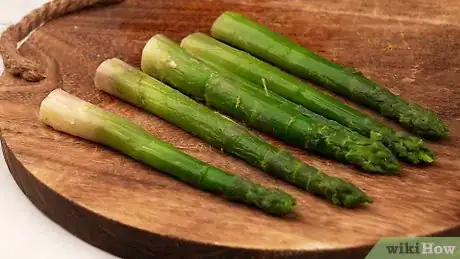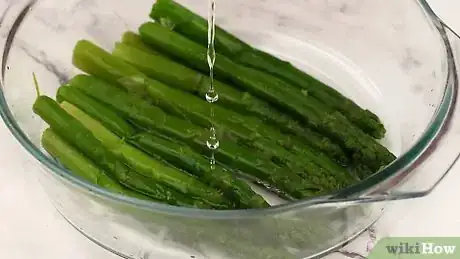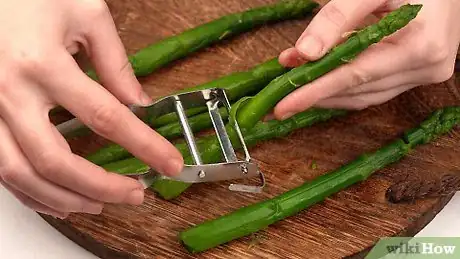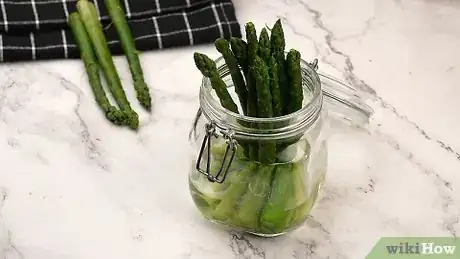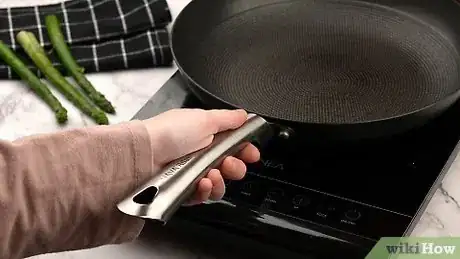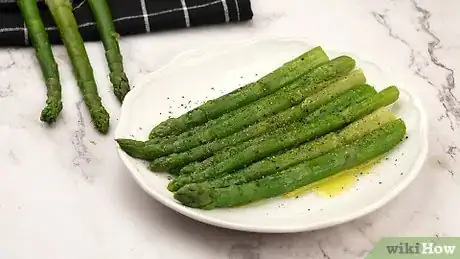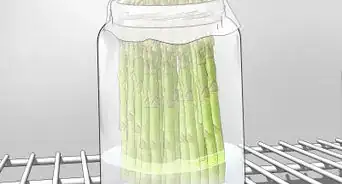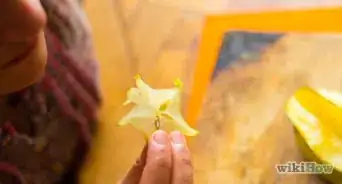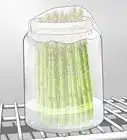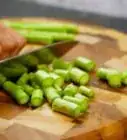This article was co-authored by Sasha Reyes. Chef Sasha Reyes is the Executive Chef and Owner of Artisan Personal Chefs. With over 20 years of food industry experience, she specializes in private dinner parties, custom sports nutrition plans for professional athletes, and cooking lessons. Chef Reyes graduated from Arizona Culinary Institute in 2011 with a degree in Culinary Arts, Baking, and Restaurant Management.
This article has been viewed 46,052 times.
Asparagus is a healthy, tasty vegetable that can be served a variety of ways. While it's considered freshest in the spring, it is available year round. Boiling asparagus is a simple, fast way to add some great nutrition to your diet.
Steps
Preparing Your Asparagus
-
1Buy a healthy batch. The most important step is picking out a good bunch of asparagus. Fresh, healthy asparagus should have the following qualities:[1]
- A bright green stalk.
- Non-shriveled tips.
- Firm, not mushy.
- Try to get batches that have uniformly-sized stalks. That way they'll all cook at the same rate.
-
2Wash the asparagus. Either by holding the stalks in your hand or placing them in a colander, run the asparagus under cold water. Concentrate on the tips, since sand or dirt can get trapped here.[2]Advertisement
-
3Trim the asparagus. While tender at the top, asparagus gets progressively harder towards the base. At the very end, it's almost like wood. You'll want to remove this base before cooking.[3]
- Grasp the asparagus at the base and the middle.
- Bend it until it snaps naturally at the transition point between the tender and hard sections.
- Lay the broken stalk flat on a table. Line up the rest of the stalks alongside it to measure how much you'll have to cut.
- Use a knife to cut off the rest of the ends simultaneously.
- For thicker pieces of asparagus, trim the bottoms of the stalks so they're the same width as the top. This will ensure even cooking.
-
4Scrape off the scales. This step is optional and can be done if you don't want the flaps on the sides of the stalks to get stuck in your teeth. Use a vegetable peeler to scrape off the scales.[4]
-
5Store the asparagus until you're ready to start cooking. If you're not going to cook your asparagus right away, store it to keep it fresh. There are two methods of storing asparagus. Either should keep your asparagus fresh for about 4 days.[5]
- Wrap the stalks in a damp paper towel. Then seal them in a plastic bag and place in the refrigerator.
- Fill a cup or container with 1 inch (2.5 cm) of water. Place the stalks in the container with the base facing the bottom. Cover the top of the container with a plastic bag and place in the refrigerator.
Boiling Your Asparagus
-
1Get a large skillet or frying pan. This should be large enough so that your asparagus can lay in the pan without bending or breaking.[6]
-
2Lay your asparagus in the pan. You should lay the stalks side by side rather than piling them on top of each other. That way you'll help all the asparagus cook evenly.
-
3Fill the pan with enough water to just cover the asparagus. This could be up to an inch for thick stalks, and as low as a centimeter if your batch of asparagus is especially thin.[7]
-
4Add a pinch or two of salt for flavor. Sprinkle a bit of salt into the pan. This is an optional step and can be skipped if you don't like salt or have any dietary restrictions.
-
5Bring the water to a boil. Turn on the flame and wait for the water to boil. Place the lid on the pan to heat the water faster.[8]
-
6Allow the asparagus to simmer for 3 to 5 minutes. After the water boils, lower the flame and let the water simmer. Keep the pan covered while the asparagus cooks.[9]
- Be sure to keep an eye on the asparagus to avoid overcooking it. Well-cooked asparagus has a bright green color and a crisp texture. Overcooked asparagus is very mushy and turns a dark shade of green. If your asparagus starts getting dark, turn off the heat and remove it.[10]
-
7Drain the water. Carefully pour the water out into the sink. To make this easier, you can strain the asparagus with a colander.
-
8Serve your asparagus. It can be served hot or cold. There are a number of ways you can jazz up your freshly boiled asparagus, including adding salt, pepper, olive oil, or lemon juice.[11]
- If serving cold, you have to cool off your asparagus quickly so it doesn't get mushy. You can do this by quickly placing the asparagus in a bowl of ice water.[12]
Things You'll Need
- Oval skillet or frying pan
- Water
- Asparagus
- Knife
- Colander (optional)
- Salt (optional)
- Vegetable peeler (optional)
Expert Interview
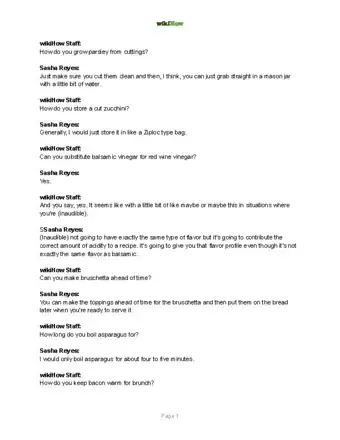
Thanks for reading our article! If you'd like to learn more about cooking techniques, check out our in-depth interview with Sasha Reyes.
References
- ↑ http://www.bhg.com/recipes/how-to/cook-with-fruits-and-vegetables/how-to-cook-asparagus/
- ↑ http://www.bhg.com/recipes/how-to/cook-with-fruits-and-vegetables/how-to-cook-asparagus/
- ↑ http://startcooking.com/how-to-cook-asparagus
- ↑ http://www.bhg.com/recipes/how-to/cook-with-fruits-and-vegetables/how-to-cook-asparagus/
- ↑ http://www.bhg.com/recipes/how-to/cook-with-fruits-and-vegetables/how-to-cook-asparagus/
- ↑ http://www.asparagus-lover.com/steaming-asparagus.html
- ↑ http://www.bhg.com/recipes/how-to/cook-with-fruits-and-vegetables/how-to-cook-asparagus/
- ↑ http://www.asparagus-lover.com/steaming-asparagus.html
- ↑ http://www.asparagus-lover.com/steaming-asparagus.html
About This Article
To boil asparagus, start by trimming off the woody bottoms of the stalks. Then, lay the asparagus flat in a large pan, and pour in just enough water to cover it. Next, bring the water to a boil before reducing the heat to a simmer. Finally, let the asparagus simmer for 3-5 minutes, or until it's bright green and crisp. For tips on how to season boiled asparagus, scroll down!
